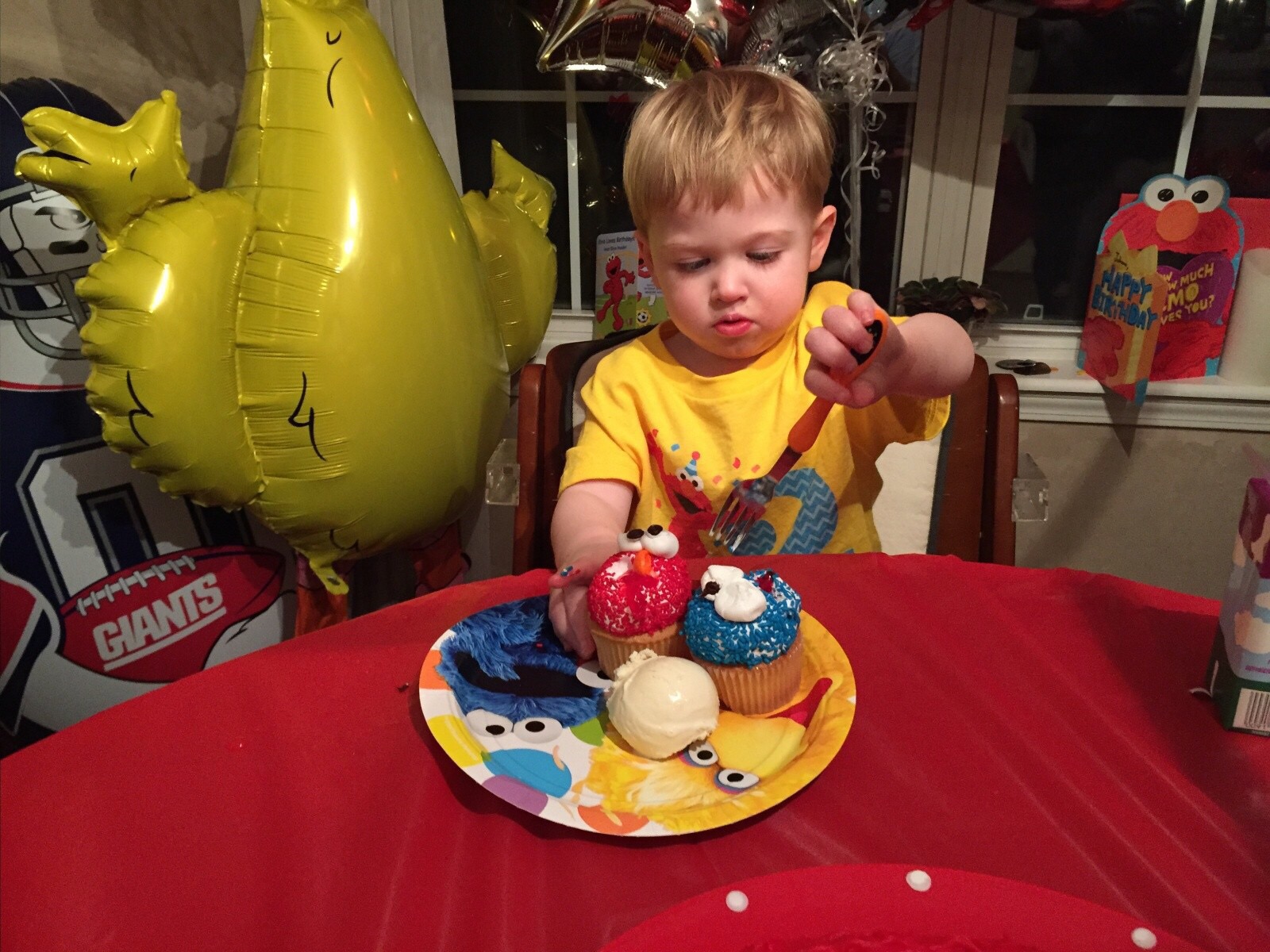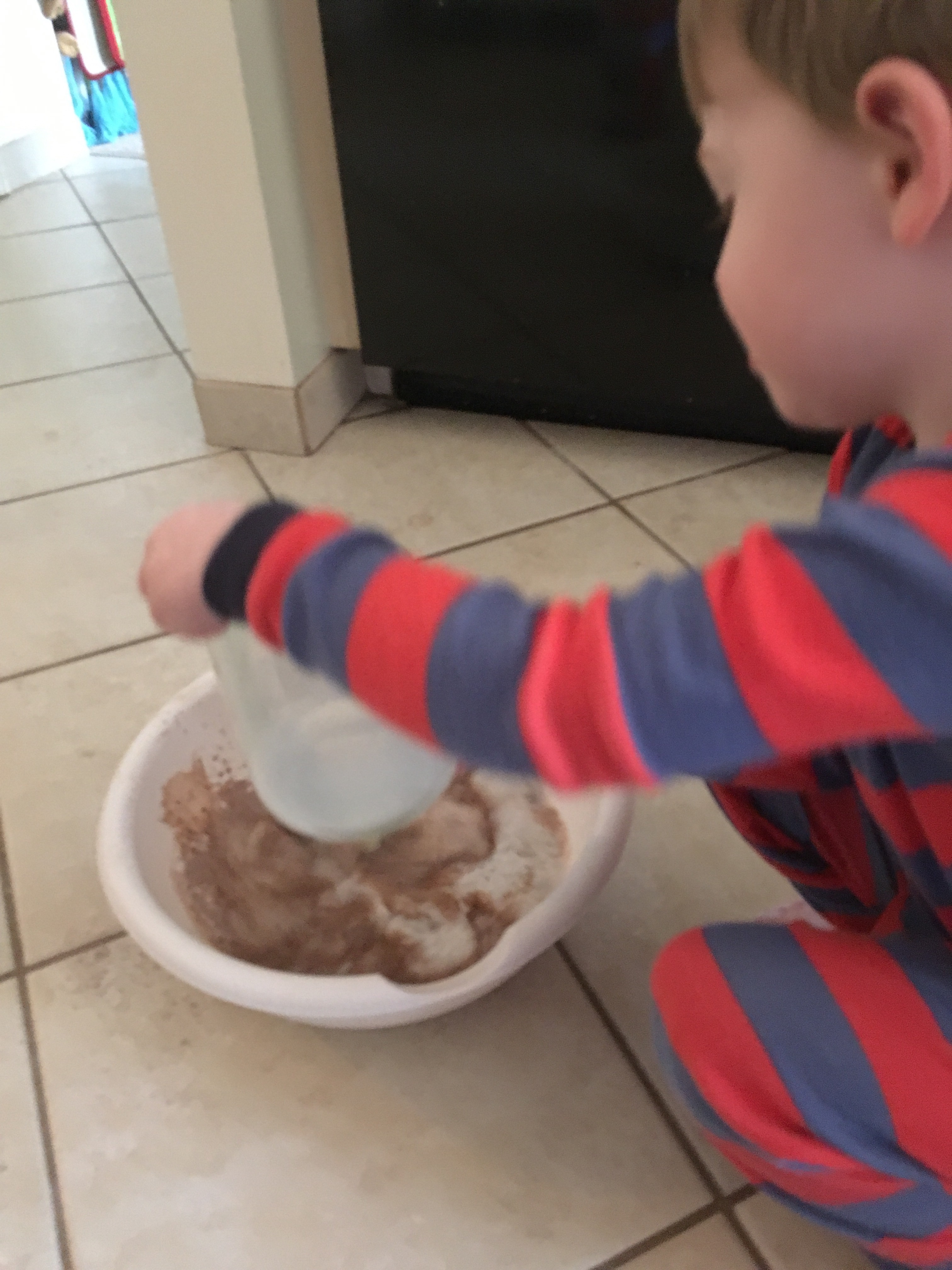Right now, anything is possible for the Mets next season because Yoenis Cespedes signed a four year $110 million contract to remain with the team. Seriously, nothing can be ruled out.
We should see fancier cars. The team will certainly have state of the art waffle makers at Spring Training. Almost assuredly, there is no way the Mets will be able to keep Cespedes off the golf course. There will certainly be interesting walk-up music this year. After which, we will most likely see one of the many epic bat flips Cespedes has at his disposal.
More importantly, the Mets will have a player who could put a stamp down as being one of the most dynamic outfielders in Mets history. That is no small statement considering Darryl Strawberry played at a Hall of Fame caliber level with the Mets, and Carlos Beltran furthered his chances of becoming a Hall of Famer during his time in Flushing.
And with that, anything is possible in 2017. That goes double when you consider Matt Harvey, Jacob deGrom, and Steven Matz will be rejoining Noah Syndergaard in the starting rotation next season. Between the pitching and Cespedes bat in the middle of the lineup, the Mets could beat anybody in 2017. Name the team, and at a minimum, the Mets have a good chance at beating them next year. That’s how much the pitching and Cespedes mean to this team.
For 2017, and the ensuing three seasons, the Mets are going to have a chance to compete for a World Series because they have the pitching and they have La Potencia. This team is now primed for a run like they were from 1984 – 1990. There is a World Series champion lurking in the Mets clubhouse right now. It’s only a matter of time before it happens. This is how much Cespedes meant to this team.
With that said, everyone, and I mean everyone should go out and buy a Cespedes jersey to not only show appreciation to Cespedes for staying, but also for the Wilpons for paying the money required to bring Cespedes back to the Mets. This organization is finally starting to spend like a big market club again, and it is happening at time when the Mets need it most.
After protecting Amed Rosario, Tomas Nido, Chris Flexen, Marcos Molina, and Wuilmer Becerra from the Rule 5 Draft, the Mets 40 man roster now stands at precisely 40 players. This means that now when the Mets look to add a player in free agency, they will have to cut one of the players off of their 40 man roster. And yes, the Mets will have to remove some players off of the 40 man roster.
From all indications, even if the Mets do no re-sign Yoenis Cespedes, they are pursuing other outfielders to replace him. With the possible suspension of Jeurys Familia looming, it is likely, the Mets will have to add one, if not two, late inning relievers. The team may be interested in bringing back Jerry Blevins or finding another LOOGY. In addition to those moves, there are some other moves or upgrades the Mets may make this offseason. With that in mind, here are some players whose spot on the 40 man roster is tenuous:
PITCHERS
Heading into the 2015 season, Edgin was supposed to be the Mets LOOGY for years to come. Those plans changed when he needed Tommy John surgery causing him to miss the entire 2015 season.
He returned in 2016, and he was not the same pitcher having lost velocity off of all of his pitches. He went from having a mid-90s fastball to having a low 90s fastball. As a result, Edgin got hit around. In AAA, he had a 3.51 ERA and a 1.650 WHIP. In his limited stints in the majors, he had a 5.23 ERA and a 1.548 WHIP. Another complication for Edgin is he is arbitration eligible meaning the Mets are presumably going to have to pay him a lot more to keep him on the roster.
On a positive note, Edgin still did get left-handed batters out at the major league level. In a very small sample size (20 plate appearances), lefties only hit .235 off of him with no extra base hits. It is a big reason why he was on the Wild Card Game roster when the Mets faced a San Francisco Giants team stacked with lefties. Between his ability to get lefties out, the hope his arm could improve a second year removed from surgery, and his still having options available, there is still some hope for Edgin.
Gilmartin has gone from an important bullpen arm the Mets acquired in the 2014 Rule 5 Draft to a player who is seemingly lost his ability to get batters out.
Despite Gilmartin being a valuable long man in the pen, the Mets had him start the year in AAA to become starting pitching depth. In 18 starts and one relief appearance, he was 9-7 with a 4.86 ERA and a 1.425 WHIP. On a couple of occasions, he was recalled, and he pitched exclusively in relief for the Mets. Things did not go well for him in those 14 relief appearances as Gilmartin had a 7.13 ERA and a 1.585 WHIP. Between his performance and his having to go on the minor league disabled list with shoulder soreness, it was a lost year for Gilmartin.
Some of the struggles of Gilmartin were the result of his uneven usage between AAA and the majors. The other issue was his shoulder soreness, which for now, appears to no longer be an issue. Another strong factor in his favor is the fact that he is not yet arbitration eligible meaning the Mets do not have to pay him much to see if he returns to form. His having options available is also a positive. The Mets could still keep him on the roster with the idea of returning him to the role he was most successful.
There is perhaps no Mets pitcher that evokes such split opinions than Goeddel. For years, there were people who saw a pitcher that was able to go out there and get outs. There were others who saw a guy who had fringy stuff that was more the beneficiary of good luck than good pitching. After the 2016 season, most people agree that Goeddel was a liability for the Mets.
In 36 appearances for the Mets, Goeddel had a 4.54 ERA and a 1.318 WHIP. It should be noted this was a big departure from how he had previously pitched with the Mets. In 2014 and 2015, Goeddel had a combined 2.48 ERA and a 1.000 WHIP. His prior success, his pre-arbitration status, and his having options remaining, gives him a chance to remain on the 40 man roster.
How he is still on the 40 man roster is anyone’s guess. Entering the 2016 season, the Mets had it with him, and they sent him a message by making him one of the first people sent down to minor league Spring Training. Montero responded by pitching so poorly in Las Vegas that he was demoted to Binghamton. It was only due a rash of pitching injuries that he got a shot at pitching in the majors again, and like his other opportunities, he squandered that. Still, despite all that, the Mets cut Eric Campbell and Jim Henderson, AND exposed Paul Sewald to the Rule 5 Draft all for the sake of holding onto Montero that much longer. Eventually, you have to assume Montero is going to get cut from the roster. It is only a matter of when.
Strangely enough, the Mets had to make a decision on whether to expose Verrett to the Rule 5 Draft or to remove a player from the 40 man roster to protect him. The Mets chose the former, and lost him for a period of time. After Verrett struggled with the Rangers, the Mets took him back where Verrett pitched well out of the bullpen and the rotation for the Mets.
The Mets envisioned Verrett succeeding in that role in 2016, but it wasn’t to be. He wasn’t as effective replacing Matt Harvey in the rotation as he was in 2015. He went from a 3.63 ERA as a starter to a 6.45 ERA. He performed so poorly out of the rotation that the Mets gave Montero a chance to start over him down the stretch of the season.
Still, there was a silver lining to Verrett’s 2016 season. In his 23 relief appearances, he had a 2.84 ERA. When you consider his reliever ERA, how well he performed in 2015, his pre-arbitration status, and his having options remaining, there is still a chance for Verrett to remain on the 40 man roster.
POSITION PLAYERS
Thinking of Plawecki being on the bubble is a bit odd especially when he is only 25 years old, has shown himself to be a terrific pitch framer, and he has only had 409 plate appearances at the major league level.
The problem there is Plawecki hasn’t hit at all in those 409 plate appearances. In his brief major league career, Plawecki is a .211/.287/.285 hitter. That’s worse than what Rene Rivera could give you, and Rivera has firmly established himself as Noah Syndergaard‘s personal catcher. Worse yet, Plawecki is not the defensive catcher Rivera is.
When you also consider Tomas Nido‘s breakout season in St. Lucie possibly forcing the Mets to protect him a year earlier than anticipated, the Mets are going to be faced with the dilemma of carrying four catchers on their 40 man roster. With Nido perhaps passing him as the catcher of the future, and Travis d’Arnaud having shown he has more offensive ability than Plawecki, it is quite possible, Plawecki could find himself having run out of chances with the Mets organization.
With all that said, it is hard to believe the Mets moving on from Plawecki this soon is his career.
This is an interesting situation for Kelly to be in considering he was signed to be minor league depth last season. With a rash of injuries and some hot hitting in AAA, Kelly finally reached the majors after his long seven year odyssey in the minor leagues.
After some time, the Mets actually discovered who Kelly was. Despite his switch hitting skills, he really could only hit from the right-hand side against major league pitching. He was versatile, but his best position was left field. Overall, his main asset down the stretch in September was as a pinch runner. He was mostly used as a pinch runner because of the dearth of team speed on the Mets roster. With all the said, he did make the Wild Card Game roster, and he got a pinch hit single off Madison Bumgarner.
Basically, all the reasons you can make for him being kept on the roster or being cut from the roster are the same exact things you could have said about Campbell, and he just signed a deal to play in Japan.
Overall, it is hard to guesstimate how many of these players are going to remain on the roster because we are not sure how many moves the Mets are going to make this offseason. Normally, you would say Montero was sure to be cut, but he is more and more looking like the pitching version of Campbell . . . there is just no getting rid of the guy. Still, as we learned from Campbell, there is going to become a breaking point, and that point may well be when the Mets sign enough players this offseason to take them from the Wild Card back to being World Series contenders.
Editor’s Note: a version of this story was originally run on Mets Merized Online
The Mets ranked dead last in the majors with a .225 team batting average with runners in scoring position. As a result of this and other issues, there was much hand-wringing over the Mets offense, and by natural extension of that, hitting coach Kevin Long. However, lost in all of the hand-wringing and finger-pointing was the fact that many of the Mets batters actually had a good season. In fact, much of this correlated with these batters working with Kevin Long. Here are some examples:
Entering the 2016 season, Cabrera was a career .267/.329/.412 hitter who averaged 28 doubles, 11 homers, and 57 RBI. Last year, the year that enticed the Mets to move quickly on the shortstop in free agency, Cabrera hit .265/.315/.430 with 28 doubles, 15 homers, and 58 RBI. Cabrera was much better than that this season.
Overall, Cabrera, while dealing with a knee injury all season long, hit .280/.336/.474 with 30 doubles, 23 homers, and 62 RBI. Judging on that alone, it was Cabrera’s best year at the plate (and his second best season as per OPS+). However, those numbers don’t tell the full story. After Cabrera came off the disabled list in August, he finished the season hitting .345/.406/.635 with 11 doubles, 10 homers, and 29 RBI. Effectively speaking, a healthier Cabrera helped power the Mets to the postseason.
Entering the 2016 season, Walker was a career .272/.338/.431 hitter who averaged 25 doubles, 13 homers, and 60 RBI. Despite this being a year in which Walker dealt with numb feet and missed the month of September due to back surgery, Walker hit .282/.347/.476 with nine doubles, 23 homers, and 55 RBI. Overall, Walker tied his career high in homers and had his highest slugging percentage and OPS. He also had his second highest batting average and OBP. It was his third highest OPS+. If Walker was healthy or played in September who knows how much better those numbers would’ve been.
On their own those numbers were great, but there was a significant improvement to Walker’s game. Despite Walker being billed as a switch-hitter, he really wasn’t. Entering the 2016 season, Walker hit .260/.306/.338 with six homers and 75 RBI over seven major league seasons. As a right-handed batter in 2016, Walker hit .330/.391/.610 with eight homers and 16 RBI. He was a completely different hitter from the right side of the plate who more than doubled his career home run total from that side of the plate. With that Walker went from a switch-hitter in name only to a real threat from both sides of the plate.
Entering the 2015 season, Cespedes was a career .263/.316/.464 hitter who averaged 27 doubles, 24 homers, and 87 RBI. He was a batter that struck some fear when he cane to the plate, but he was hardly considered one of the top power hitters in the game.
When Cespedes game to the Mets at the trade deadline last year that all changed. In 57 games, Cespedes hit .287/.337/.604 with 14 doubles, 17 homers, and 44 RBI. The numbers were striking as they were unexpected. This year, Cespedes proved those numbers weren’t a mirage. In 132 games with the Mets, Cespedes hit .280/.354/.530 with 25 doubles, 31 homers, and 86 RBI. It’s all the more impressive when you consider Cespedes did this while dealing with a quad issue for about half the season. During Cespedes tenure with the Mets he has hit for a higher average, OBP, SLG, and homers. He is now one of the most feared power hitters in the game.
Sometimes becoming an effective player is just focusing on the things you do well as a player. As we have seen in Flores’ young career, the two things he does well is hit for power and hit left-handed pitching. Before going down for the season with a wrist injury, Flores was at his absolute best in both departments.
In 107 plate appearances against left-handed pitching, Flores hit .340/.383/.710 with four doubles, 11 homers, and 28 RBI. For the season, Flores hit .267/.319/.469 with 14 doubles, 16 homers, and 49 RBI. It was a career best batting average, OBP, and slugging for Flores in a season he tied his career high in homers. It should also be noted that Flores was getting progressively better as 2016 progressed. With that, Flores showed he was not just an improved hitter in 2016, but he was a player who is poised to have an even better 2017.
Before being traded to the Mets yet again, Johnson was hitting .215/.273/.289 for the Braves. When Johnson returned to the Mets, he asked Long to do for him what Long did for Daniel Murphy. The result was Johnson hitting .268/.328/.459 with eight doubles, nine homers, and 24 RBI in 82 games. With the 34 year old Johnson didn’t just turn his season around, he might’ve also lengthened his career.
In response to the positive impact Long had on some key contributors to the 2016 season, many Mets fans will point to some of the perceived failures of Long this season. Just remember the numbers don’t tell the whole story.
With respect to Travis d’Arnaud and Michael Conforto, their numbers will tell you both players took a major step back in 2016. However, Conforto had a wrist injury, and d’Arnaud had a shoulder injury. Those injuries most likely had a big impact on their performances especially when you consider Conforto hit .365/.442/.676 and was the major league leader in hard hit ball percentage.
Another player many fans will point to is Curtis Granderson, who took a step back from his outstanding 2015 season. It should be noted, Granderson hit .302/.414/.615 in the final month of the season, and he became the oldest Mets outfielder to hit 30+ home runs in a season.
As for the rest of the team, many suffered their injuries, and they had their ups and their downs as the season progressed. However, the Mets were able to withstand the injuries and the ups and downs of the season because the Mets got some terrific and unexpected offensive seasons from some of their players. Kevin Long goes a long way in explaining how that happened.
Editor’s Note: this was first published on Mets Merized Online
Throughout the season, I attempted to grade the different Mets players performances for each month of the season. In determining the year end grades, the aggregate of the monthly grades given was considered, but it wasn’t conclusive. For example, one player’s awful month could be more than offset by having an incredible month. Also, those decisions were made in the heat of the moment. There has been a cooling off period in giving these finals grades, and with that, there is time for reflection. It should also be noted the Wild Card Game did have some impact on these grades as that game was part of the story of the 2016 Mets. Overall, the final grades assessed considered the monthly grades, but also took into account that player(s) overall impact on the Mets season (good or bad). For the tenth and final set of grades, here is Terry Collins grade:
Sometimes grading a manager can be difficult. For starters, we cannot truly know how much of an impact the manager has in the clubhouse. For example, one person’s “player’s manager” is another person’s “letting the inmates run the asylum.” Essentially, that narrative is written based upon the type of year the team had.
Furthermore, in the modern game, we are unsure how much of an impact the front office has on daily decision making. It used to be that the General Manager would hire a manager, and then he would step aside and let the manager run the team as he saw fit. Now, there is a some level of interference in each organization. Some provide data and other tools to the manager while others are at least rumored to try to fill out line-up cards for teams.
If we are being honest, there really are times we do not know what is and what is not a manager’s fault. However, we do know that everything lies at the manager’s feet, and it is ultimately the manager that will have to be responsible for the choices made. Looking at Terry Collins’ choices is complicated. Lets review:
The Good
If you are being fair, Collins did what he was paid to do by bringing the Mets to the postseason in consecutive seasons. That is no small feat, especially for a franchise that has only done it once before in their entire history. There was also a large degree in difficulty in doing so, especially when you lose Matt Harvey, Jacob deGrom, and Steven Matz to season-ending surgeries at different points in the season.
He also had to deal with a number of other injuries. There was the fairly expected ones like David Wright, the reasonably foreseen like Lucas Duda, and the out of nowhere like Wilmer Flores. Yoenis Cespedes dealt with a quad issue most of the summer too. Once again, it was not a ringing endorsement of the medical and training staff this season. Still, Collins dealt with it, and took a team that was two games under .500 in August, and the Mets claimed a Wild Card spot. Again, teams normally collapse in these circumstances. Collins’ team showed resolve, and for that, he deserves a lot of credit.
A major reason why was the emergence of Seth Lugo and Robert Gsellman. These two young players contributed much earlier than expected and were better than anyone ever expected. One reason why is Collins matched them up with Rene Rivera who has excelled mentoring young pitching. Collins deserves credit for that as he does matching up Rivera with Noah Syndergaard to help alleviate the issues associated with Syndergaard holding on base runners. Collins use of Rivera might’ve been the best decision he made all season, and it could very well have been the reason why the Mets returned to the postseason.
The Bad
The one issue I cannot get over all season was how reckless Collins was with his bullpen arms. It wasn’t aggressive. It wasn’t demanding. The only real term to use was reckless.
In April, he put Jim Henderson into a day game after a night game despite Henderson coming off shoulder surgeries and Henderson having thrown a career high in pitches the previous night. The reason? Collins determined an April game was a must-win game. In a sport that plays 162 games, no April game can be considered a must-win. During that inning, Henderson had no velocity, couldn’t get a guy out, and he would have to be lifted from the game. After that outing, Henderson wasn’t the same guy that made the team out of Spring Training, and he would have to be put on the disabled list with a shoulder injury. He went from lock down seventh inning guy to removed from the 40 man roster as soon as the season ended.
Then there was Hansel Robles. Collins treated him like every arm he ruined in his past. Despite having a number of guys who could go more than one inning, including long man Logan Verrett, it was Robles who was called to the whip time and time again. During a one week stretch in June, Robles threw 127 pitches over three mutiple inning appearances. Then when he finally got some rest, Robles came right back out and threw 33 pitches over two innings. Robles sustained the abuse well for most of the season, but then he tailed off at the end of the year.
Somehow, someway Addison Reed and Jeurys Familia never got injured. It really is a miracle because they were used more than any other combination of relievers in baseball in 2016. The wear and tear finally showed in the Wild Card Game when neither pitcher had much of anything left. Both struggled in their respective innings of work. Reed was able to get out of it, but Familia wasn’t.
While the bullpen usage was an issue, there were other problems with Collins. He completely mishandled Michael Conforto this season. Conforto had gone from one of the best hitters in baseball in April, to a guy Collins outright refused to play down the stretch of the season despite Conforto hitting nearly .500 in AAA during his demotion.
Keep in mind, Conforto was not the only player who regressed this season. Travis d’Arnaud had looked prime to break out in 2016. Unfortunately, his season was marked by injuries and regression. With Conforto and d’Arnaud, there are two important young players who regressed under Collins.
Finally, there was the matter of how injuries were handled. Harvey’s injury issues were blamed on mechanics. Collins kept putting Cespedes out there everyday to play despite his clearly being hobbled. Same goes for Asdrubal Cabrera. The worst might have been talking Matz out of getting season ending surgery in order to pitch through what was described as a massive bone spur. Eventually, Matz would have to scrap his slider, would experience some shoulder discomfort, and he would finally get shut down for the season.
Overall
In a sport where you are judged by wins and losses, Collins was successful despite the issues he faced. However, many of those issues were self-inflicted. Given the fact that he brought the team to the postseason for a consecutive year, he should have received a high grade. However, Collins consistently risked the health of his players, and some were worse off as a result. You need to look no further than Henderson who is right now looking to catch onto a team yet again. Even worse yet, the young players the Mets need to take them to the next level next year are question marks due largely to Collins’ mishandling of them. Altogether, Collins season earned him a C-.
Editor’s Note: the grades for April, May, June, July, August, and September/October can be found by clicking the links.
This Thanksgiving, I wanted to make something with my son that was fairly quick and easy and something he could practically do on his own. The solution was a S’mores Pie.
The ingredient list is easy. First, you need a graham cracker crust. There are several easy recipes to make it from scratch, or you can just buy the premade crust.
Next, you need some type of chocolate pudding. If you’re making it with a two year old, I suggest instant pudding.
Last, you’ll need marshmallows. The mini-marshmallows work best.
Once you have these ingredients, it’s easy to make.
First, if you dare, have your child measure out the milk to mix with the pudding:
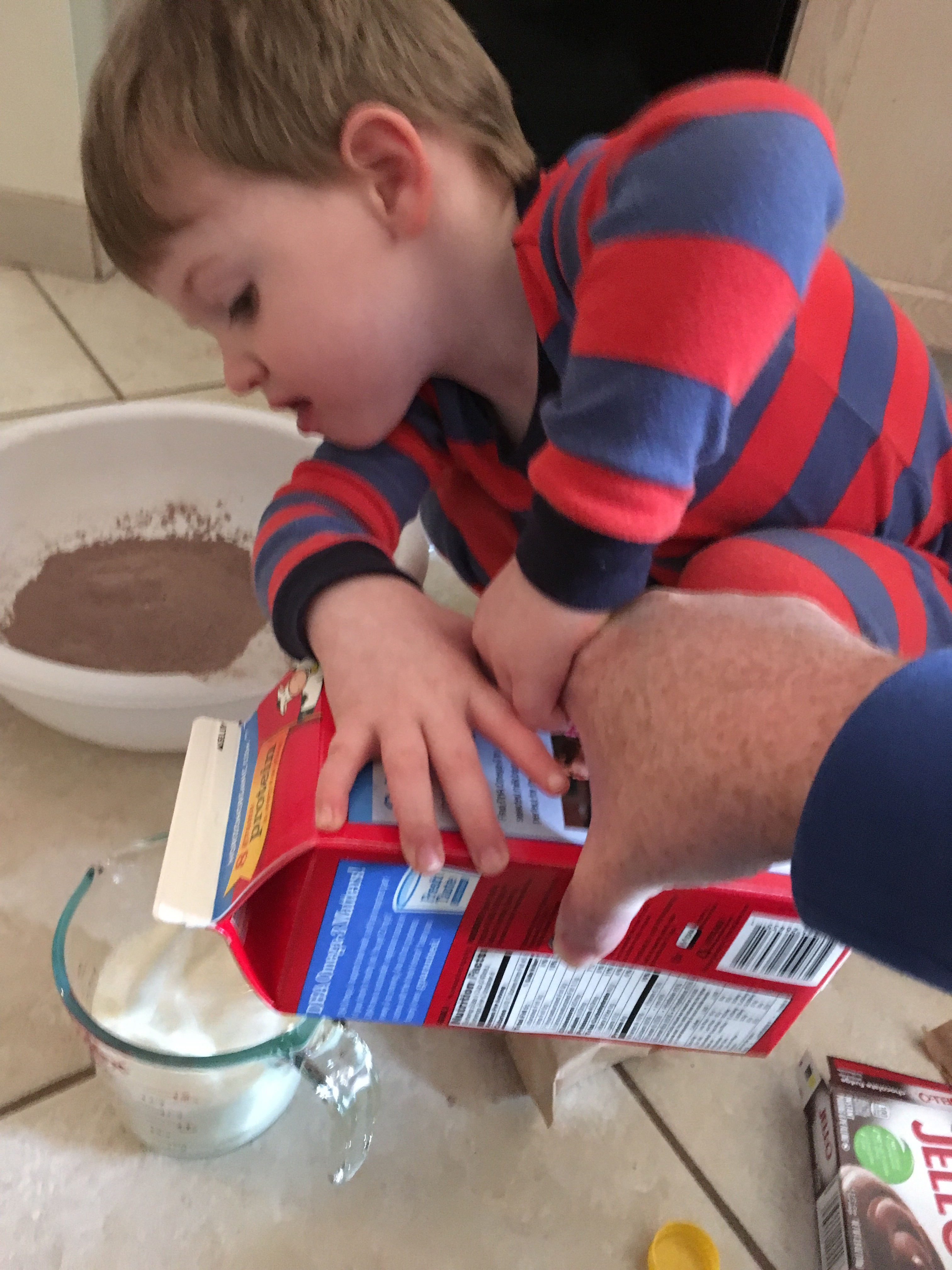
I recommend using a measuring cup that uses the precise amount of milk needed. I used a two cup measuring cup as the instant pudding required two cups of milk. As you can see from his focus, his eyes are fixated on the “2” on the measuring cup.
Once measured out, pour the milk right into the bowl with the instant pudding . . .
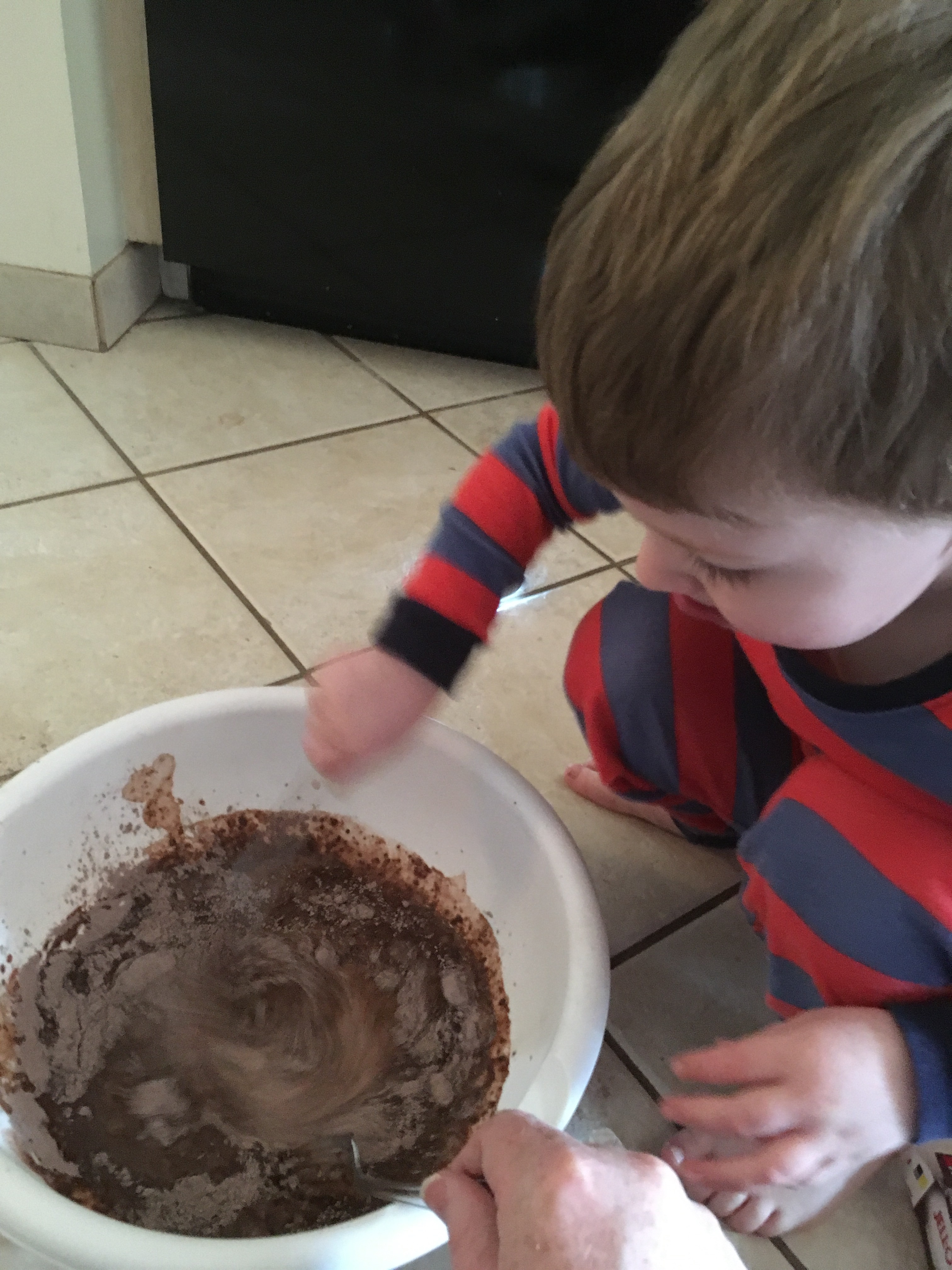
Once fully mixed, you’ll probably need to help a bit here, it’s time to add the pudding to the graham cracker crust:
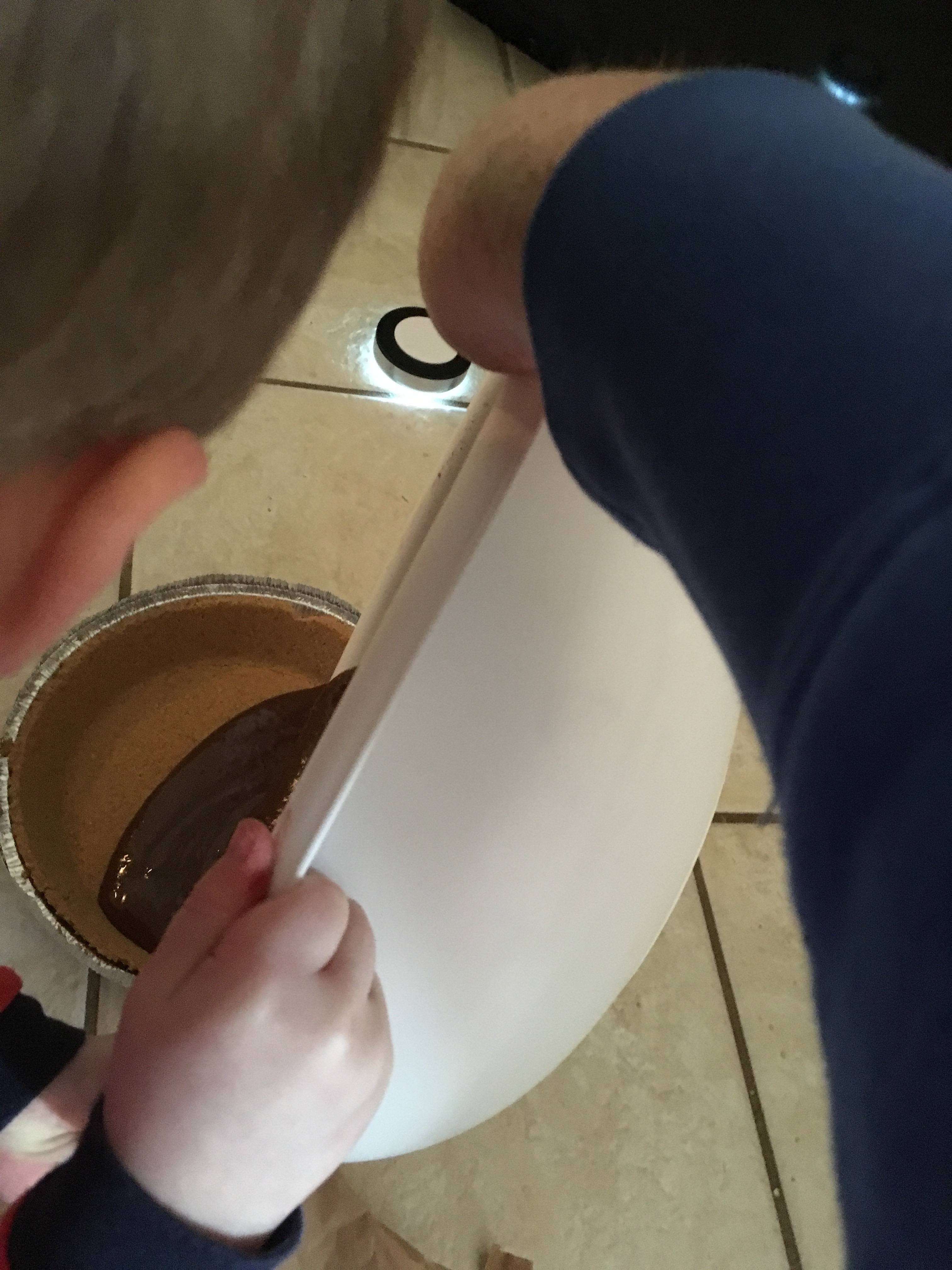
You’ll need a spatula to scrape all the pudding out and to even out the pudding in the pie crust.
Once that is done, it’s time to add the marshmallows:
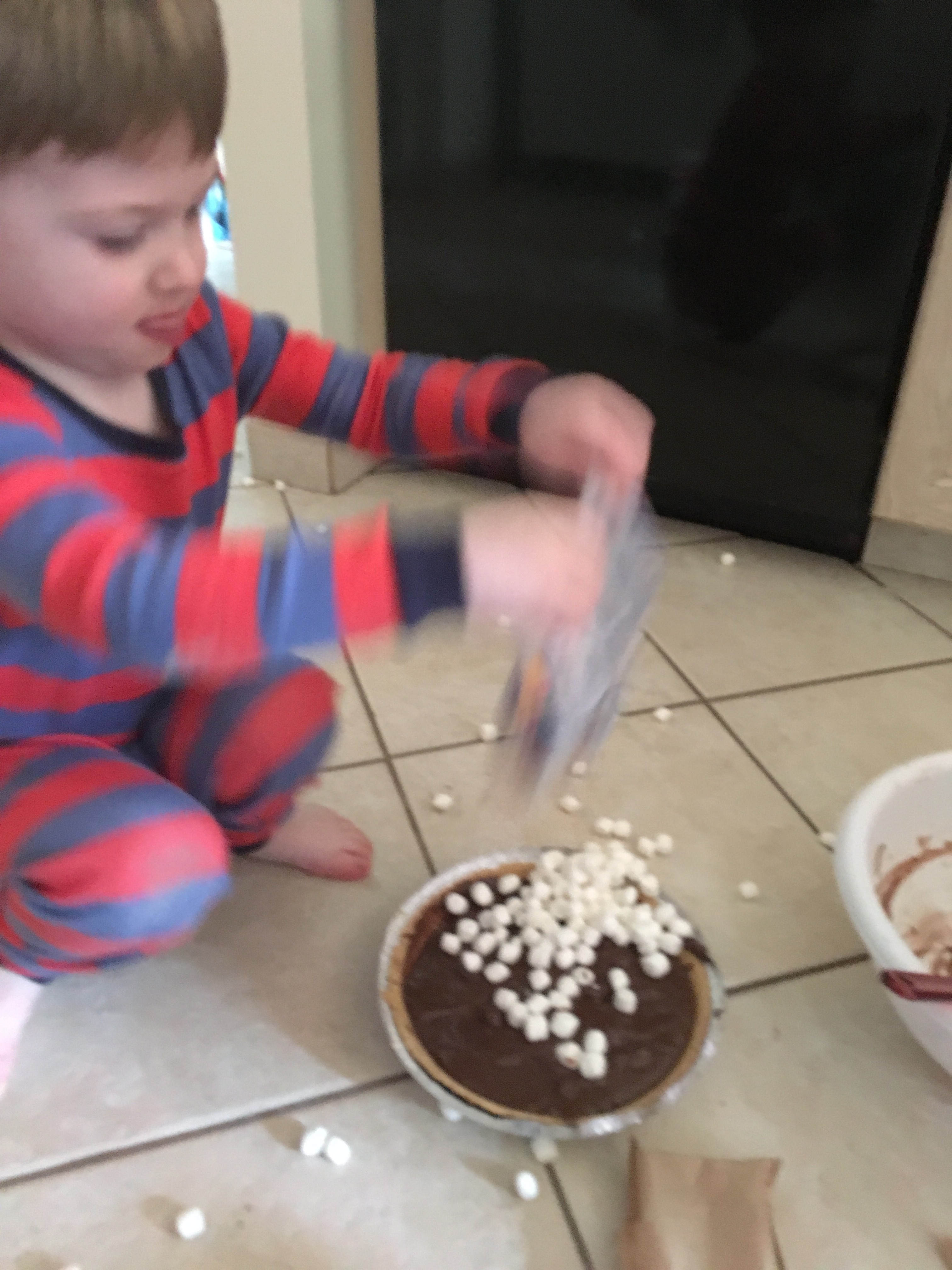
In retrospect, I shouldn’t have given him the bag. Fortunately, I had a second bag. With that second bag, I put them in a bowl, and I had my son cover the rest of the top.
From there, it’s time to stick it in the fridge until it is time to serve:

As it was also grandma’s birthday, the pie also served as a “birthday cake.”
In theory, you could use a torch or something else to melt down the marshmallows before serving.
Overall, this was a fun and easy way to let your toddler make a dessert. It’s also a versatile recipe.
For Christmas, use broken up candy canes to top.
For Easter, maybe use vanilla pudding and top with Peeps.
You could even do a more traditional shortbread crust with banana pudding and whipped cream.
Really, anything is possible even if you just want to do any type of pudding covered with whipped cream.
You can’t go wrong with it. Everyone is going to love it, and your child will have the pride of having made a dessert everyone loves.
With Mike Piazza having been elected into the Baseball Hall of Fame, it does not appear there will be another player who will be inducted into the Hall of Fame as a Met until Carlos Beltran is eligible. Still, there are players with Mets ties on this year’s Hall of Fame ballot. Can you name them? Good luck!
Jeff Kent, Gary Sheffield, Billy Wagner, Mike Cameron, Melvin Mora
To paraphrase the late great Ralph Kiner, I wish everyone on this blessed Thanksgiving a Happy Birthday!
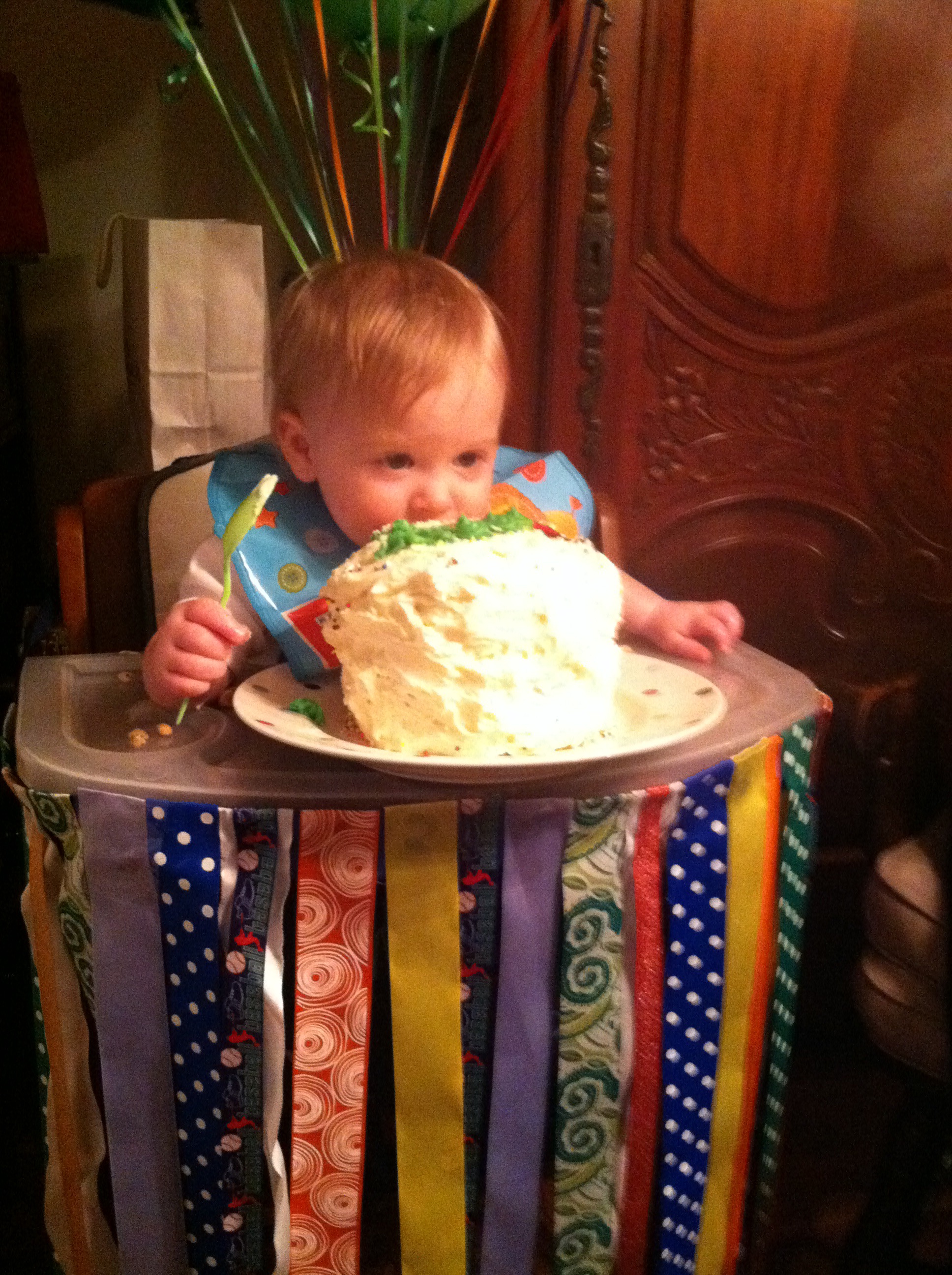
My little guy was born the day before Thanksgiving, and for our first meal as a family, we had pizza and pasta (what the hospital offered).
His first birthday was on Thanksgiving.
As a result, each Thanksgiving is special. It’s a reminder that the holiday was the first full day our family was a family. It’s also a milestone on how much my little guy has grown.
Last year, I put together a Christmas shopping list for toys I either knew my son wanted or for items I thought would be good for a two year old. Looking over the list, some of the items are actually still good items to purchase for a three year old. Notably, I would say my son has gotten tremendous use out of his Thomas Table, and I presume he will continue to do so in the years to come. I know it is a big ticket item, but it has been worth every penny we spent on it (especially since we got it for half-price on Black Friday).
One note to keep in mind, avoid this year’s big toy if at all possible. If you have been in Toys R Us, you know the toy I’m referring to is the Sky High Bridge Jump Set. When assembled, this toy is eight feet long! It is going to dominate your living room, play room, basement, etc. With that in mind, you cannot keep it out all of the time, which creates too much stress and frustration. Just think of the amount of times you are going to have to assemble and disassemble it. Then keep it mind, it is the Track Master (motorized Thomas set) meaning your standard wooden Thomas cannot be used with it. Again, avoid it at all costs.
While I discourage that, here are some toys, I wholeheartedly recommend:
- Thomas Minis and at least one carrying/storage case.
- Thomas Minis Motorized Raceway
- Wooden Railway Expansion Packs and Sets
- Tumble Train
- Disney Pixar Cars sets or Hot Wheels
- Cars Playsets
- Busy Books
- Phonics Books
- Tricycle (preferably one you can hold onto)
- Big Wheels
- Scooter
- Roller Skates
- Helmet
- Puzzles
- Mr. Met
Not on this list, but also recommended is Play-Doh, Legos and Duplos, and books. Always, lots and lots of books for kids. In terms of books, I personally recommend a collection like you will see with Dr. Seuss. This permits you to get a number of books at a fraction of the cost, and it permits you to try to get your kid to read more than just one story over and over again.
Two other things to keep in mind: (1) you will need batteries; and (2) you will need a place to put all of this stuff. It may behoove you to give the carry kits as a gift or to get a new toy box.
While some of these items are more expensive, keep a look out for them at Toys R Us, Target, Walmart, Amazon, etc. this Black Friday and beyond. While you are out there this Black Friday, look for toys your child can use next year (if you have the storage space). You will be thankful for every penny you save on stuff like this you were likely going to buy anyway.



